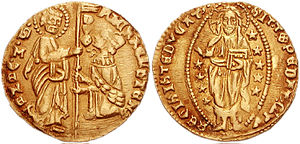Coinage of the Republic of Venice
From the 16th century, the coinage was made in the very prominently-located Zecca of Venice, close to the Doge's Palace.
The gold ducato was later known as zecchino; this had the doge's image receiving the standard from St. Mark on the obverse.
The zecchini remained unchanged from the first issue, in 1284, to the last one, during the reign of the last doge of Venice in 1796, Ludovico Manin.
See Zecca of Venice for the organization and operations of the mint in the Renaissance and the remaining centuries of the Venetian Republic.
The coinage was rigidly controlled by the Council of Forty, an assembly with financial-economical tasks, also acting as Supreme Court.



